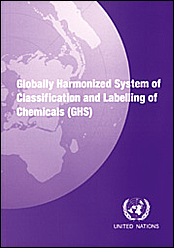https://www.osha.gov/hazcom/pictograms
OSHA - Occupational Safety & Health Administration
Regulatory. The mission of OSHA is to ensure safe and healthful working conditions for working men and women by setting and enforcing standards and by providing training, outreach, education and assistance.
29 CFR 1910 - Occupational Safety & Health Standards
Hazard Communication Pictograms - These GHS Hazcom pictograms are available in EPS, JPG, and PNG formats.
Safety Data Sheets (SDS) - OSHA requires SDS for each hazardous chemical on site.
Side-by-Side Comparison of OSHA's Existing Hazard Communication Standard (HCS 1994) vs. the Revised Hazard Communication Standard (HCS 2012) - This OSHA page will help you understand what you need to do to comply with the new standard.
Laboratories - This OSHA page addresses the "Laboratory Standard" and includes it's interpretations, hazard recognition, possible solutions, and additional information.
A Guide to The Globally Harmonized System of Classification and Labelling of Chemicals (GHS) - This system, developed by the United Nations, provides infomation on standardized classification and labelling of chemicals. This is sometimes refered to as the UN GHS Purple Book.
Toxic and Hazardous Substances: Occupational exposure to hazardous chemicals in laboratories (29 CFR 1910.1450) - This OSHA regulation includes the requirement of a Chemical Hygiene Plan (1910.1450(e)). e-CFR
Toxic and Hazardous Substances: Hazard Communication (29 CFR 1910.1200) - This OSHA regulation ensures that the hazards of all chemicals produced or imported are evaluated, and that information concerning their hazards is transmitted to employers and employees. e-CFR
Guidance for Hazard Determination - This guide provides information and advice to assist in compliance with the OSHA Hazard Communication Standard (29 CFR 1910.1200).
Chemical Reactivity Hazards - Chemicals have the ability to react when exposed to other chemicals or certain physical conditions. The reactive properties of chemicals vary widely and they play a vital role in the production of many chemical, material, pharmaceutical, and food products we use daily.
Eye and Face Protection - Thousands of people are blinded each year from work-related eye injuries that could have been prevented with the proper selection and use of eye and face protection. Eye injuries alone cost more than $300 million per year in lost production time, medical expenses, and worker compensation.
Laboratory Safety Guidance - This document is intended for supervisors, principal investigators and managers who have the primary responsibility for maintaining laboratories under their supervision as safe, healthy places to work and for ensuring that applicable health, safety and environmental regulations are followed.
Updates - 29 CFR 1910.1200 and 29 CFR 1910.1450 Appendix A
e-CFR - Electronic Code of Federal Regulations 29 CFR 1910 Subpart Z - Toxic and Hazardous Substances
OSHA Fact Sheets
- Laboratory Safety - OSHA Laboratory Standard
- Laboratory Safety - Chemical Hygiene Plan (CHP)
OSHA Quick Cards
- Hazard Communication Safety Data Sheets
- Hazard Communicaiton Standard Labels
- Hazard Communication Standard Pictogram


